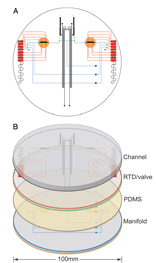 ABI’s smallest sequencer is about the size and weight of a house air conditioning unit [ABI 310: 95 kg (208 lbs); 61 x 56 x 86 cm (24 x 22 x 34 in)]. Researchers who developed the Mars Organic Analyzer for detecting extraterrestrial life recently turned their attention to DNA sequencing. In 9 May 2006 PNAS Blazej, Kumaresan, and Mathies from the University of California, Berkeley, report on a microfabricated DNA sequencer comprised of three 10 cm glass wafers. Using 1 femtomole of DNA template and a 250 nanoliter reaction chamber, the device performs thermal cycling, DNA purification, and capillary electrophoresis, generating reads of up to 556 bases with 99% accuracy. Based on their results “the template/reagent requirements can be reduced an additional 100-fold, and a fully integrated microfluidic genomic sequencing system should also lead to significant infrastructure and labor savings.”
ABI’s smallest sequencer is about the size and weight of a house air conditioning unit [ABI 310: 95 kg (208 lbs); 61 x 56 x 86 cm (24 x 22 x 34 in)]. Researchers who developed the Mars Organic Analyzer for detecting extraterrestrial life recently turned their attention to DNA sequencing. In 9 May 2006 PNAS Blazej, Kumaresan, and Mathies from the University of California, Berkeley, report on a microfabricated DNA sequencer comprised of three 10 cm glass wafers. Using 1 femtomole of DNA template and a 250 nanoliter reaction chamber, the device performs thermal cycling, DNA purification, and capillary electrophoresis, generating reads of up to 556 bases with 99% accuracy. Based on their results “the template/reagent requirements can be reduced an additional 100-fold, and a fully integrated microfluidic genomic sequencing system should also lead to significant infrastructure and labor savings.”
Faster, cheaper, more portable sequencing should facilitate “point-of-use” DNA barcoding devices for identifying specimens in the field, detecting invasive species at the customs station, and sorting through museum drawers for undescribed species, for example.
I want my Tricorder now:)
Keep up the good work.